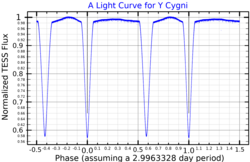Binary star in the constellation Cygnus
Y Cyg
|
Observation data
Epoch J2000 Equinox J2000
|
| Constellation
|
Cygnus
|
| Right ascension
|
20h 52m 3.57718s[2]
|
| Declination
|
+34° 39′ 27.4861″[2]
|
| Apparent magnitude (V)
|
7.3 - 7.9[3]
|
| Characteristics
|
| Primary
|
| Spectral type
|
O9.5V[4]
|
| Apparent magnitude (U)
|
5.91[citation needed]
|
| Apparent magnitude (B)
|
6.996[citation needed]
|
| Apparent magnitude (V)
|
7.287[4]
|
| U−B color index
|
−1.086[4]
|
| B−V color index
|
−0.291[4]
|
| Secondary
|
| Spectral type
|
O9.5V[4]
|
| Apparent magnitude (U)
|
5.883[citation needed]
|
| Apparent magnitude (B)
|
6.974[citation needed]
|
| Apparent magnitude (V)
|
7.265[4]
|
| U−B color index
|
−1.091[4]
|
| B−V color index
|
−0.291[4]
|
| Variable type
|
Algol[3]
|
| Astrometry |
|---|
|
|---|
| Proper motion (μ) | RA: +2.763[2] mas/yr
Dec.: −15.981[2] mas/yr |
| Parallax (π) | 0.6759 ± 0.0338 mas[2] |
| Distance | 4,900 ly
(1,500[4] pc) |
| Absolute magnitude (MV) | −3.59/−3.62[4] |
Absolute bolometric
magnitude (Mbol) | −6.65±0.04/−6.7±0.04[4] |
|
|---|
| Orbit[4] |
|---|
| Primary | Y Cyg A |
| Companion | Y Cyg B |
| Period (P) | 2.99633210±0.00000031 d |
| Semi-major axis (a) | 28.72 R☉ |
| Eccentricity (e) | 0.14508 |
| Inclination (i) | 86.474±0.019° |
| Periastron epoch (T) | 2,446,308.66407±0.0001 |
Argument of periastron (ω)
(secondary) | 312.514° |
Argument of periastron (ω)
(primary) | 132.514±0.052° |
| Details[4] |
|---|
| Primary |
|---|
| Mass | 17.72±0.35 M☉ |
| Radius | 5.785±0.091 R☉ |
| Luminosity | 36,000 L☉ |
| Surface gravity (log g) | 4.161±0.014 cgs |
| Temperature | 33,200±200 K |
| Rotational velocity (v sin i) | 132 km/s |
| Age | 2 Myr |
| Secondary |
|---|
| Mass | 17.73±0.3 M☉ |
| Radius | 5.816±0.063 R☉ |
| Luminosity | 37,700 L☉ |
| Surface gravity (log g) | 4.157±0.01 cgs |
| Temperature | 33,521±40 K |
| Rotational velocity (v sin i) | 132 km/s |
| Age | 2 Myr |
| Other designations |
|---|
Y Cyg, HD 198846, HIP 102999 |
| Database references |
|---|
| SIMBAD | data |
Y Cygni is an eclipsing and double-lined spectroscopic binary star system in the constellation of Cygnus. It is located about 4,900 light-years from Earth. The system was one of the first binaries with a convincing detection of the apsidal precession.[4]
The two stars, being O-type main-sequence stars, orbit each other with a period of nearly 3 days.[4]
- ^ Cite error: The named reference
MAST was invoked but never defined (see the help page).
- ^ a b c d e Cite error: The named reference
DR3 was invoked but never defined (see the help page).
- ^ a b Cite error: The named reference
gcvs was invoked but never defined (see the help page).
- ^ a b c d e f g h i j k l m n o Cite error: The named reference
harmanec2014 was invoked but never defined (see the help page).
